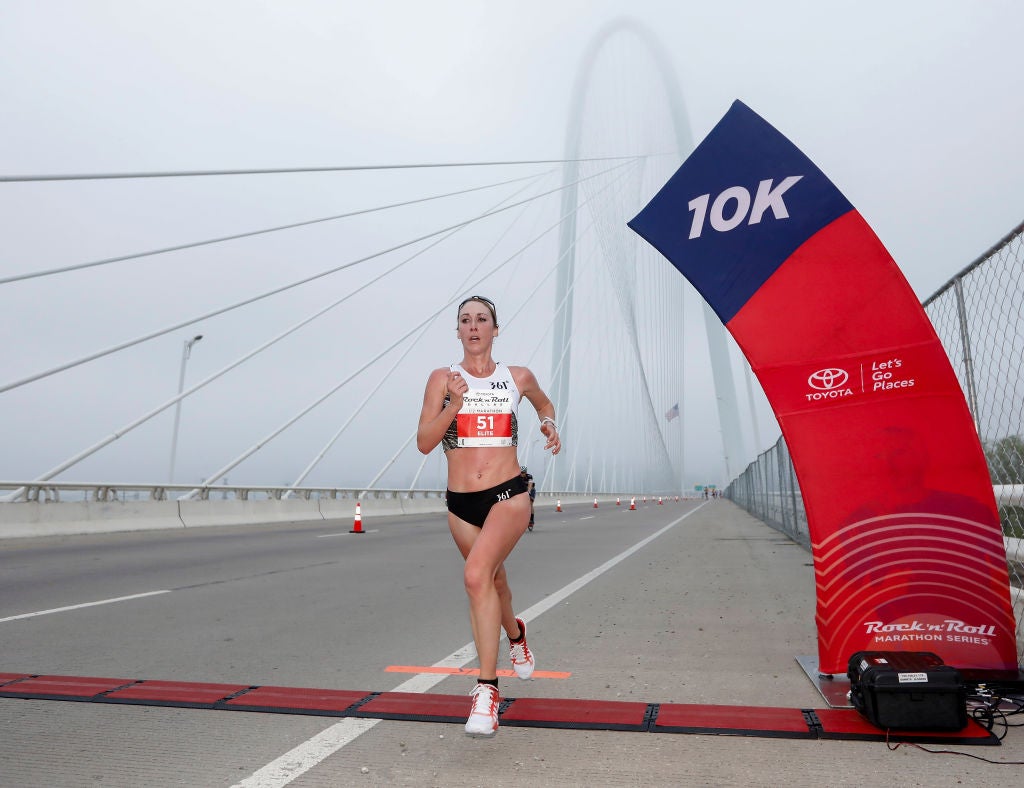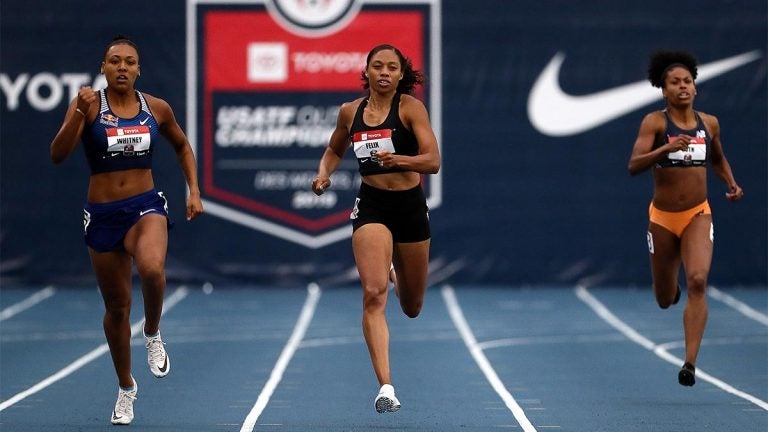What Happens When An Athlete Takes ‘The Pill’?
Why this matters
Athletes who menstruate face enormous decisions over whether to take contraceptives, how to measure their own physical performance while on “the pill,” and potentially when to stop the regimen.
Sarah Crouch assumed that someone would have an answer. A doctor, maybe. Or a coach. Someone. It was the early 2010s, and Crouch, a marathon runner, was about to get married. She didn’t yet want to have children, so she was considering birth control.
As a professional athlete running as many as 140 miles a week, Crouch knew that even small changes to her diet or training could have a large impact on her performance. “With distance running, you have to be consistent,” she says. “Day in and day out.”
Crouch wondered what she could expect if she started using an intrauterine device (IUD), an implant that keeps sperm cells from reaching an egg, or if she began taking oral contraceptives, commonly known as “the pill,” which work by manipulating hormone levels in the body to prevent pregnancy from occurring.
One day, Crouch sat down in front of her computer. She searched: effects of various types of birth control on runners.
“I pulled up absolutely nothing,” says Crouch, 32. “I was shocked. It was like nobody had ever studied it.”
Dumbfounded, Crouch sent a message on Facebook to 60 other elite female distance runners. What did they know about sports performance and birth control?
Almost immediately, Crouch says, she was flooded with responses. Most expressed similar frustration. With nowhere else to turn, many of the other runners had relied on individual trial and error to discover how contraceptives – particularly the pill – influenced their bodies and times.
“It made me a little angry,” Crouch says. “To know that women would reach 25, 30 years old as professional athletes, with every aspect of their lives controlled and tweaked down to an inch – but in this one area, there was no research and no answers. It’s a difficult and lonely landscape.”
Among elite athletes, contraceptives are commonly used both to prevent pregnancies and to manage menstrual cycles. Yet surprisingly little is known about how contraceptives can affect sports performance. Few studies have explored the connection, and those that exist are limited in scope. Until recently, the topic largely was ignored, in part because the female body’s natural hormonal fluctuations can make research more difficult and in part because of long-standing bias in research toward cisgender males.
The result? When deciding whether or not to use the pill and other forms of hormonal birth control, athletes such as Crouch are largely on their own – because medicine science currently has more questions than answers.
“A lot of really well-intentioned sports medicine doctors don’t understand that this is a major issue for female athletes,” says Dr. Kate Ackerman, director of the Female Athlete Program at Boston Children’s Hospital and doctor for U.S. national rowing team. “And, for now, we don’t have that one formula that fits everyone. We need more research. There is so much for us to learn.”
‘A Pretty Big Impact’
While running for Arizona State University from 1998 to 2002, Lisa Aguilera used the pill. A former All-American, she never considered how doing so might impact her finishing times. “I think everyone just got on [the pill] in college,” she says. “I don’t remember ever having any discussions about it affecting performance.”
That changed after Aguilera became a professional runner and began working with Canadian track coach Wynn Gmitroski. Gmitroski, Aguilera says, was “super into everything you put in your body,” encouraging runners to give up sugar, dairy, and gluten – as well as oral contraceptives. Gmitroski explained that taking oral contraceptives can lower levels of testosterone, a hormone that helps build lean muscle mass.
“He told me every woman he ever coached got better when she stopped taking it, and that it would have a big impact,” Aguilera says.
Aguilera was wary about making major changes. She first cut gluten out of her diet, then dairy. “I lost about five pounds,” she says. Eventually, Aguilera stopped taking the pill, which she had been using for roughly a decade. “I do feel like that had a pretty big impact,” she says. “I felt stronger, leaner. I ran my fastest time in the steeple with [Gmitroski] coaching me.
“Once I had an awareness, I would ask a lot of other female runners on runs, ‘what do you take? How does it affect you?’ People were realizing how [the pill] was affecting our hormones.”
Oral contraceptives consist of synthetic hormones that mimic the natural ones in female bodies. In simple terms, they function by overriding the menstrual cycle, a repeating pattern of natural hormonal shifts that allow pregnancy to happen and also result in periods.
For an athlete with a female reproductive system, the menstrual cycle can have a noticeable impact on performance. In studies, fluctuating hormone levels have been linked with decreased muscular strength, increased sensations of exertion and pain, changes in how well the body uses stored energy, greater risk of knee ligament tears, and higher core body temperatures – the latter of which can potentially result in earlier onset of fatigue.
Most people who menstruate experience some form of premenstrual syndrome (PMS), characterized by a range of physical and emotional symptoms that occur five to eleven days before menstruation and include anxiety, insomnia, bloating, and muscle aches. During periods, painful cramps and heavy bleeding also can affect athletic performance; following a relay race at the 2016 Rio Olympics, Chinese swimmer Fu Yuanhui was asked by a reporter why she was holding onto her stomach.
“I feel I didn’t swim well today. I let my teammates down,” she said. “My period came last night, and I’m really tired now. But this isn’t an excuse. I still didn’t swim as well as I should have.”
It’s not uncommon for people who menstruate to use the pill not only to prevent pregnancies but also to exercise more control over their menstrual cycles. By keeping hormone levels more stable, oral contraceptives can help athletes minimize PMS symptoms, make bleeding lighter and more predictable, and skip bleeds altogether during important competitions.
A 2018 study of 430 elite female athletes from 24 sports including hockey, soccer, and rowing found that about half used some kind of hormonal contraceptive. Of that group, 12.7 percent said that they liked the regularity of the pill, while 12.2 percent said that they liked being able to reduce the number of bleeds they experienced.
“For an athlete who has a high need for control, to all of the sudden have their period can cause them to panic and not perform well,” says Steve Magness, a longtime track and field coach who has worked with world-class distance runners. “The pill eliminates that anxiety of ‘Oh, my gosh, my Olympic trials race is going to fall during the time I get my period and have cramps, and how am I going to do that?’”
Related: ‘A Big Struggle’: In Retirement, Athletes Can Face a Jarring Physical Transition
For some athletes, however, the pill is far less helpful. A 2011 survey of 123 skiers and biathletes by FasterSkier found that 71 percent had used hormonal birth control. Of those, almost half believed that it had negatively impacted their performances via weight gain, reduced strength and endurance, mood swings, loss of competitive drive, and other factors.
Two standout high school skiers told FasterSkier that after starting hormonal birth control just before going to college, their performances either stagnated or declined – that is, until each decided to stop taking contraceptives. One of those athletes, Clare Egan of Wellesley College, went on to qualify for the 2010 National Collegiate Athletic Association championships in skiing and was named a Division III All-American in track and field.
“If you look at my athletic performance, someone would say, ‘Wow, is this person on drugs?’” Egan told FasterSkier.
Former Arizona State and professional runner Victoria Jackson can relate. She began taking the pill in high school – not for contraception, but to ease painful cramping and other symptoms. When she stopped more than a decade later, she says, her body felt stronger. And her overall mood, which she describes as “kind of deflated,” became much lighter.
“I felt frickin’ amazing,” says Jackson, a sports historian and clinical assistant professor at Arizona State and contributor to Global Sport Matters. “My physical and mental health improved. And I was, like, super angry that I had been using [the pill] for so long.
“None of this is scientific. This is just me interpreting how I felt. But I do know a lot of runners who don’t do any hormonal intervention at all, because they just don’t feel great when they do it.”
Limited Research, Limited Evidence
So what can science say about the connections between birth control and athletic performance? The research that exists is patchy, often conducted on non-athletes, and it is generally more suggestive than conclusive – sometimes producing contradictory results.
For example, a 1997 study from researchers at San Diego State University showed that athletes who menstruate who used oral contraceptives experienced higher heart rates and core temperature increases after exercising in higher temperatures than women who did not. By contrast, a more recent study from the University of Hull in the United Kingdom found that athletes taking the pill were more likely to acclimatize better and quicker in hot conditions compared to those who didn’t.
Similarly, some studies have found that the pill produces no significant effect on muscle growth, while others have found that people using hormonal birth control have less available testosterone and a harder time gaining muscle than those who aren’t.
A 2020 review of 42 separate studies of the effects of oral contraceptives on exercise performance in athletes who menstruate concluded that while using the pill “might result in slightly inferior” performance, the effects were too “trivial and variable” to provide one-size-fits-all guidance to athletes.
“Anytime you’re taking a medication, there’s a huge list of potential side effects,” Ackerman says. “With birth control pills, some people might (gain weight). Other people might not. Some people might say it makes them grouchier. Some might say it improves their mood.
“In general, there is limited evidence to show that [the pill] benefits or hinders performance. But better studies need to be done.”
Such studies are arguably overdue. The U.S. Food and Drug Administration approved the first oral contraceptive in 1960. Title IX, the federal civil rights law that prohibits sex-based discrimination in schools or education programs receiving federal funding and has spurred major growth in women’s sports participation, was enacted in 1972.
To understand why scientific progress has been so slow, consider a common sight in office buildings everywhere: men in short sleeves, women wrapped in blankets or using space heaters. This is no accident. In the 1960s, standard office temperatures were developed around the metabolic resting rate of the average man – even though the same rate for women is much lower, which results in offices being on average five degrees too cold for them.
This bias toward studying men and designing the world around them – all while ignoring women or assuming that they are, effectively, smaller men – is widespread. And it extends to sports medicine. A review of 1,382 exercise medicine studies published from 2011 to 2013 found that women made up just 39 percent of total study participants; a follow-up evaluation of 188 exercise studies published in early 2015 found that women accounted for 42 percent of subjects – and in the 29 of those studies that focused specifically on training to recover and perform better, women made up just 3 percent of participants.
Somewhat ironically, one of the main reasons males have been studied more than females is that the complexities of the menstrual cycle and its effects carry over into research. “It’s definitely easier to study men who don’t have a cycle,” Ackerman says. “It’s more expensive to study women. If you’re a researcher, you need to get a lot of money in order to be able to do this correctly.”
Related: Women in the Undercurrent of Sport Are Thriving
Longstanding cultural taboos around female bodies and reproductive health also play a role. Two years ago, Sportico reported that at least four schools in the Power Five conferences prohibited advertising and sponsorships for sanitary napkins, tampons, panty liners, menstrual cups, and period underwear – placing those products in the same category as escort services, sexually explicit materials, erectile dysfunction medications, tobacco, gambling, and politics.
In the 2011 FastSkier article, a doctor for the U.S. Biathlon Association said that he didn’t usually talk about birth control with national team athletes. “It just isn’t discussed openly,” says Crouch, who in addition to competing has also coached female runners. “If a woman has a male coach, how comfortable is she going to that coach and saying, ‘My doctor recommended birth control. What do you think?’
“When you’re a 14- or 15-year-old girl, you don’t even want to talk to your own mother about your period. There’s something a little bit secretive, and that can carry over later into life. With female athletes I’ve coached, I’ve had some say, ‘Hey, I’ve been running really really well lately.’ I’ll ask them what has changed, and they’ll say, ‘Oh, I went off birth control a few months ago.’ Even I didn’t think to ask them!”
Stigma can be dangerous. When Australian researcher Brooke Brisbine surveyed nearly 300 women’s rugby and football players and 250 coaching staff members about breast injuries, she found a remarkable discrepancy. More than half of the athletes reported experiencing injuries while playing, yet the coaches estimated an injury rate of less than 5 percent.
Why the gap? According to Brisbine, she was the first person to ever ask most of the athletes if they had suffered a breast injury.
Until recently, athletes whose periods stopped were often told by coaches and doctors that they were experiencing a normal side effect of vigorous training. Some of those athletes were also given hormonal contraceptives in order to resume regular bleeding.
However, irregular or absent periods also can be a symptom of Relative Energy Deficiency in Sport (RED-S), a syndrome that occurs when athletes don’t consume enough calories and nutrients for their level of exercise, which in turn leaves their bodies without sufficient energy to support functions such as the menstrual cycle and healthy bone density.
In cases of RED-S, Ackerman says, the pill can mask the underlying problem, leaving athletes more vulnerable to broken bones and hormonal disruption “There can be many reasons to not get a menstrual cycle,” she says. “If it is because of RED[-S], the key is to improve your energy balance. If you give someone the pill, they are not necessarily going to do that.”
For Magness, who has a reputation as an innovative and research-based coach, the lack of understanding around performance and the pill is a source of ongoing frustration. “My background is in exercise science,” he says. “In undergrad and grad school, I learned plenty about testosterone and its effects on performance. But I didn’t learn anything specific about women and the pill.
“It wasn’t until I started coaching female athletes and they would ask me about it that I realized this was a problem. And the research was so inconclusive that I would give wishy-washy answers to athletes whose careers depend on some of this stuff.”
‘We Go Through Something Very Different’
Things may be changing. During the 2019 World Cup, U.S. Women’s National Soccer Team coaches tracked players’ menstrual cycles and symptoms to optimize their sleep, nutrition, and training regimens. Chelsea F.C. Women, a professional soccer team in the English Premier League, has since followed suit in an effort to enhance its play and reduce injury risk.
In an interview with Telegraph Sport, Chelsea manager Emma Hayes said that she first became interested in the connection between menstrual cycles and on-field results during a 2016 loss to rival Arsenal in which a number of Chelsea players were “in and around their period.”
“I am a female coach in an industry where women have always been treated like small men,” Hayes said. “The application of anything from rehab to strength and conditioning to tactical all come from the basis of what men do.
“The starting point is that we are women and, ultimately, we go through something very different to men on a monthly basis. And we have to have a better understanding of that because our education failed us at school; we didn’t get taught about our reproduction systems. It comes from a place of wanting to know more about ourselves and understanding how we can improve our performance.”
Both Chelsea and the USWNT have worked with Dr. Georgie Brunivels, a research scientist at the sports bio-analytic company Orreco and co-creator of FitrWoman, an app that tracks physical activity and menstrual cycles. Brunivels is part of a rising generation of scientists – many of them women – who are working to fill in the knowledge gaps that have left coaches like Magness and athletes like Crouch at a loss.
A former competitive rower, Ackerman founded the pioneering Female Athlete Program, which in addition to treating injuries provides comprehensive care that evaluates training, nutrition, hormone levels, and mental health. She also started the Female Athlete Conference, a biennial meeting that draws sports medicine and science experts from across the globe to share research and knowledge on topics including RED-S, concussions in women athletes, sports bra design and fit, and ways the pill impacts performance.
“There are a lot of issues that are neglected in this space,” Ackerman says. “But I really feel like this is changing. We are collaborating a lot more, combining resources, and connecting the dots to collect this information and answer these questions.
“People are more engaged in female sports. These athletes are important – and they represent 50 percent of the population. We need to address the more interesting and complicated issues of women to get the most out of them.”
Monthly Issue
Sport & the Body
The body is the most fundamental component of sport, capable of unthinkable feats and requiring considerable care. Athletes continually push their bodies to the brink in order to excel at their craft, and the 21st century has brought about a reimagining of the limits of physical ability.
Yet as the world of sport intensifies its focus on the body, athletes are demanding better care, more freedom, and increased flexibility around how they maintain and shape theirs.





